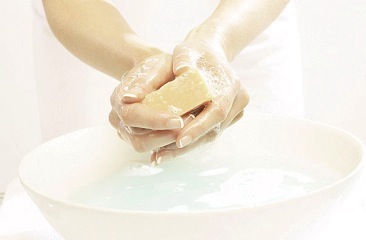-
Respiratory Conditions










Colds & Flu
Cold and flu viruses can be spread through hand shakes and touching objects that has an infected person’s mucus on them.
















Take at least 20 seconds to wash your hands using soap and running water. This is the time it takes to sing “Happy Birthday” twice.
Causes
Colds and flu are caused by viruses. You can get a cold or flu virus from mucus on the hands of a person with the virus, such as through a handshake. You can pick up the viruses on towels, telephones, money, etc. Cold and flu viruses also travel through coughs and sneezes. Each year, 36,000 people die from pneumonia and other serious problems from the flu. This is especially true for persons who are age 65 or older, frail, and/or have:
-
•A chronic lung disease, such as emphysema or bronchitis.
-
•Heart disease.
-
•Anemia.
-
•Diabetes.
-
•A weakened immune system from an illness, chemotherapy, taking corticosteroids, etc.
Treatment
Self-care treats colds and most cases of the flu.
Prescribed antiviral medicines can make flu symptoms milder and help you get better sooner if started within 48 hours of the onset of flu symptoms.
Other medications to relieve symptoms may also be advised by your doctor.
Antibiotics do not treat cold and flu viruses. Antibiotics treat infections from bacteria. Taking them for viruses is a main cause of antibiotic resistance. With this, bacteria that were once fought off by antibiotics have become stronger than the medicine. Certain bacteria have become so resistant that it is hard to find an antibiotic that is able to fight off the infection. An example is MRSA - Methicillin-resistant Staphylococcus aureus. This can cause an infection that affects the skin or causes pneumonia. MRSA resists treatment from usual antibiotics.

-
•Wash your hands often. Keep them away from your nose, eyes, and mouth.
-
•Use an alcohol-based hand rub.
-
•Use a tissue when you sneeze, cough, or blow your nose. If you don’t have a tissue, sneeze or cough into your sleeve.
-
•Try not to touch people or their things when they have a cold or the flu. If you can, stay away from persons who have the flu.
-
•Get regular exercise. Eat well. Get plenty of rest.
-
•Follow your doctor’s advice before taking vitamins, minerals, and/or herbal products that claim to prevent colds and flu.
To Treat a Cold or the Flu
-
•Rest.
-
•Drink lots of liquids.
-
•Take an over-the-counter medicine for pain and/or fever as directed.
-
•Use over-the-counter saline nasal drops or spray, such as Ocean brand. Use as directed on the label.
-
•Use a cool-mist vaporizer. This adds moisture to the air.
-
•Eat chicken soup. It helps clear out mucus.
-
•Take echinacea, zinc lozenges, and/or vitamin C as advised by your doctor when cold or flu symptoms start. Don’t take echinacea and/or zinc lozenges long term. These do not prevent colds and flu.
-
•Suck on lozenges and hard candies to moisten a sore throat. (Don’t give these to children under age 5).
-
•Gargle with: Warm salt water (1/4 teaspoon of salt in 1 cup of water) or 1 tablespoon of hot water mixed with 1 tablespoon of mouthwash.
-
•Don’t suppress a cough that brings up mucus. Ask your pharmacist for an over-the-counter expectorant medicine with guifenesin. {Note: See information on “Expectorant” in Your Home Pharmacy.}
-
•For a sore throat, see Self-Care / Prevention under Sore Throat topic.
Self-Care / Prevention
-
•The single best way to protect against getting the flu is to have a yearly flu vaccine. Guidelines for it are given every year from the Centers for Disease Control and Prevention Immunization Program. For information in English and Spanish, call 800.CDC.INFO (232.4636). On the Internet, access www.cdc.gov/vaccines. Ask your doctor if you and your children need a flu vaccine. {Note: Persons allergic to eggs should not get a flu vaccine.}
Have you had the flu or a cold for more than a week and not felt better with self-care? Or, do you have new symptoms?
Do you have pain or swelling over your sinuses that gets worse when you bend over or move your head, especially with a fever of 101ºF or higher?
Is a fever and/or other symptoms, like coughing, getting worse?
With a cold or the flu, do you have any of these problems?
-
•Wheezing or trouble breathing.
-
•Ear pain or swollen, painful neck glands.
-
•Headache that doesn’t go away.
-
•Sore throat that is very red or has white spots.
-
•A cough with mucus that is yellow, green, or gray.
-
•Temperature of 99.5ºF and up to 100.4ºF in a baby less than 3 months old.
-
•Temperature of 102.2ºF and up to 104ºF in a child 3 months to 3 years old.
-
•Temperature over 104ºF in a person 3 to 64 years old.
-
•Temperature of 102ºF or higher in a person age 65 and older.
-
•A bad smell from the throat, nose, or ears.
With or after the flu, do these signs of dehydration occur?
-
•Feeling confused.
-
•Very little or no urine.
-
•Sunken eyes.
-
•Dry skin doesn’t spring back after being pressed.
With or after the flu, do any of these symptoms of meningitis occur?
-
•Stiff neck (can’t bend the head forward to touch the chin to the chest).
-
•Severe headache that persists.
-
•Red or purple rash that doesn’t fade when pressure is applied to the skin.
-
•Seizure.
-
•Lethargy.
-
•In an infant, bulging of the fontanelle (soft spot of the skull).
Does an adult have any of these problems?
-
•Blue color around the lips, fingernails, or skin.
-
•Severe or increasing shortness of breath.
-
•Severe wheezing.
-
•Coughing up true red blood.
With a cold, does a child have one or more of these problems?
-
•Blue color around the lips, fingernails, or skin.
-
•Quick breathing or a very hard time breathing.
-
•Grunting sounds with breathing.
-
•Severe cough or wheezing.
-
•Fever of 100.4ºF or higher in a baby less than 3 months old; 104ºF or higher in a child between 3 months and 3 years old.
Questions to Ask






Get more information from:
HealthyLearn® | www.HealthyLearn.com. Click on MedlinePlus®.
Centers for Disease Control and Prevention | 800.CDC.INFO (232.4636) | www.cdc.gov



Copyright © 2009, American Institute for Preventive Medicine. All rights reserved.